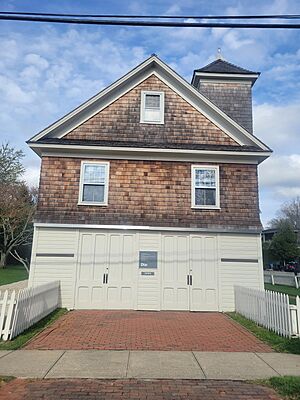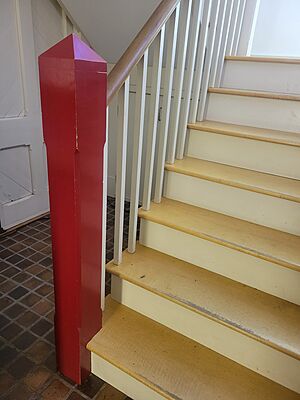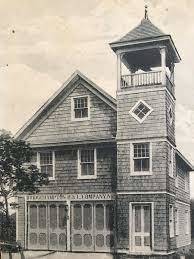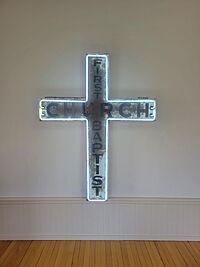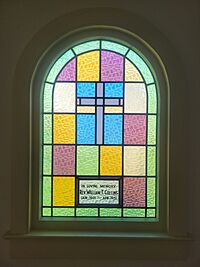Dia Bridgehampton facts for kids
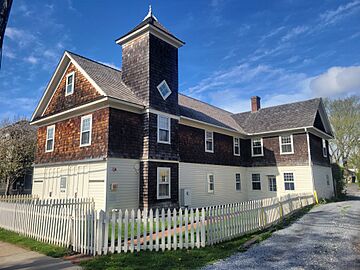 |
|
| Former name | Dan Flavin Art Institute |
|---|---|
| Established | 1983 |
| Location | 23 Corwith Avenue Bridgehampton, New York, US |
| Type | Art museum |
| Key holdings | nine works on permanent display by Dan Flavin |
| Collections | Modern and contemporary art |
| Founder | Dan Flavin and Dia Art Foundation |
| Owner | Dia Art Foundation |
| Public transit access | Bridgehampton station, Montauk Branch of the Long Island Rail Road |
Dia Bridgehampton is a special art museum in Bridgehampton, New York. It is run by the Dia Art Foundation. The museum opened in 1983 and was first called the Dan Flavin Art Institute. It was designed to permanently show the amazing fluorescent light sculptures of artist Dan Flavin.
The building itself has a cool history. It was built in 1909 as a firehouse. Later, from 1924 to 1979, it was used as a church. Dan Flavin loved this history and even included parts of it in the museum's design.
Today, the museum is called Dia Bridgehampton. It has a permanent display of Flavin's light art, which is still called the "Dan Flavin Art Institute." There is also a gallery for special, temporary art shows.
Contents
The Museum's Story
How the Museum Began
The Dia Art Foundation was started in 1974. Its goal was to help artists create big, ambitious projects. These projects were often too large or unusual for regular museums.
In 1979, Dia bought the old firehouse and church in Bridgehampton. They wanted to create a museum just for Dan Flavin's art. Flavin was a minimalist artist, which means he used simple shapes and materials. His main material was colorful fluorescent light tubes. He lived nearby and chose the building because it was easy to get to and had big, open rooms perfect for his art.
Turning an Old Building into a Museum
Major work on the building began in 1982. The architect Richard Gluckman worked with Flavin to design the museum. They fixed up the outside and completely changed the inside.
To show Flavin's art, the building needed a lot of new wiring for all the lights. Special windows were put in to control the natural light. As a nod to the building's past, the main post of the staircase was painted fire-engine red. They even created a small gallery to show items from the building's time as a church, like its old doors and a neon cross.
The museum opened on June 18, 1983. It was named the Dan Flavin Art Institute.
The Dan Flavin Art Institute
The Dan Flavin Art Institute is the main, permanent part of Dia Bridgehampton. It features nine of Dan Flavin's amazing fluorescent light sculptures and one of his drawings. The collection shows all the major types of art he created with light.
The museum wants visitors to see the lights and the building as one single work of art. Flavin used light to create interesting feelings. He played with different colors, brightness, and shapes to make people think and feel.
The following table lists the artworks you can always see at the museum.
| Title | Date | Material | Edition | Owner |
|---|---|---|---|---|
| red out of a corner (to Annina) | 1963 | Fluorescent light and metal fixtures | 2/3 | The Estate of Dan Flavin |
| untitled | 1976 | Fluorescent light and metal fixtures | 2/3 | Dia Art Foundation |
| untitled (to Robert, Joe, and Michael) | 1975-81 | Fluorescent light and metal fixtures | 2/3 | Dia Art Foundation |
| untitled (to Jan and Ron Greenberg) | 1972-73 | Fluorescent light and metal fixtures | 2/3 | Dia Art Foundation |
| untitled (in honor of Harold Joachim) 3 | 1977 | Fluorescent light and metal fixtures | 1/3 | Dia Art Foundation |
| untitled (to Katharina and Christoph), (from the European Couples series) |
1966-71 | Fluorescent light and metal fixtures | 1/5 | Dia Art Foundation |
| untitled (to Jim Schaeufele) 1 | 1972 | Fluorescent light and metal fixtures | 1/3 | Dia Art Foundation |
| untitled (to Jim Schaeufele) 2 | 1972 | Fluorescent light and metal fixtures | 1/3 | Dia Art Foundation |
| untitled (to Jim Schaeufele) 3 | 1972 | Fluorescent light and metal fixtures | 1/3 | Dia Art Foundation |
| untitled drawing for icon IV (the pure land) (to David John Flavin [1933–1962]) |
1962 | Pencil and chalk on paper | N/A | Collection of Stephen Flavin |
The Building's Unique History
The museum building has lived many lives. Dan Flavin made sure to honor its past when he turned it into a space for art.
A Home for Firefighters
In 1895, Bridgehampton started a volunteer fire department. They were called the Bridgehampton Hook and Ladder Company. For years, they kept their fire engine in a barn.
In 1905, the company bought land and built a headquarters. The building was finished in 1909. The first floor held the firefighting equipment. The second floor was a meeting room called "Fireman's Hall." A bell was installed in the tower to call the firefighters to action. The firefighters used this building until 1923, when they moved to a new, larger community building.
A Place of Worship
In 1924, the First Baptist Church of Bridgehampton bought the old firehouse. They used it as their church for over 50 years. In 1947, the building was renovated. The main entrance was moved, and a new section was added.
By the 1970s, the church's community had grown too large for the building. They built a new church nearby, and the old building was sold.
Remembering the Past
A room on the second floor is like a small museum of the building's history. It displays items from when it was the First Baptist Church. You can see the old church doors, a stained-glass window, and a large neon cross.
This display is important. It shows how Flavin took something ordinary, like a light fixture, and turned it into art. The neon cross, once a religious symbol, is now seen in a new way, as part of the building's story.
Special Art Exhibitions
The first floor of Dia Bridgehampton has a gallery for temporary art shows. These shows change about once a year. When the museum first opened, Dan Flavin himself chose the art for this gallery. He showed works by his friends and other artists he admired, like Andy Warhol.
After Flavin's death in 1996, the gallery's focus changed several times. For a while, it showed more of Flavin's own art. Later, it featured works by other famous artists like Fred Sandback and John Chamberlain.
Since 2017, the gallery has focused on artists who live or work on Long Island. These artists are invited to create new art that connects with the museum. Some artists make work that responds to Flavin's light sculptures. Others are inspired by the building's history or the land around it. This keeps the museum fresh and exciting for visitors.
See also
- List of works by Dan Flavin


